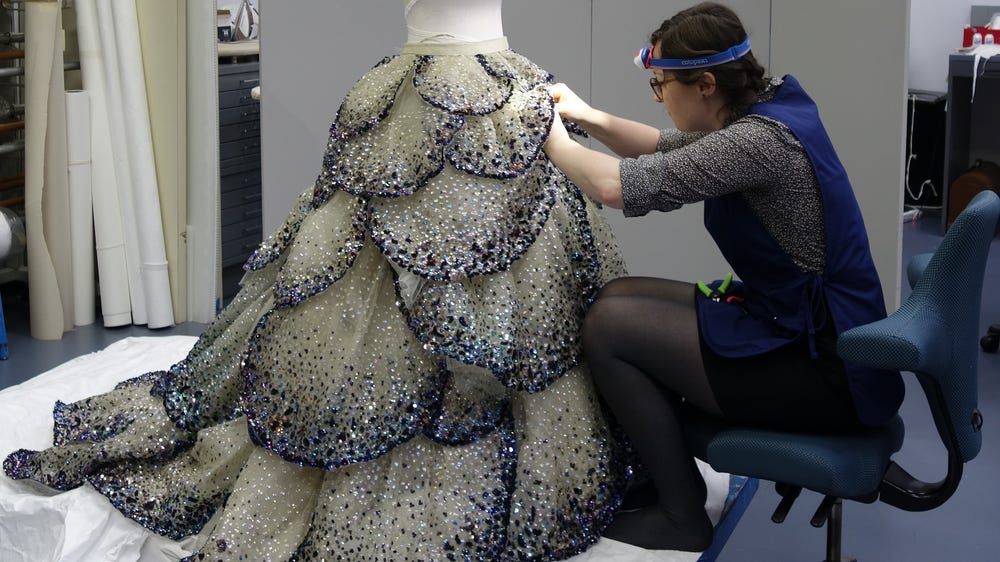
Sister Dresses: Christian Dior’s “Junon” and “Venus”
Among the greatest strengths of the Fine Arts Museums of San Francisco’s fashion collection are its exemplary holdings of designs by the preeminent French couturier Christian Dior. From the debut of his first collection in 1947 until his untimely death a decade later, Dior produced garments that were antidotes to the austere fashions of World War II, with superb construction and tailoring, ample use of luxurious fabrics, and an abundance of sumptuous decorative treatments.
The designer’s “Junon” gown, along with its sister design, “Venus,” represents the pinnacle of his creativity. Named in honour of the Roman goddess of marriage and fertility, “Junon” is formed from diaphanous layers of silk tulle, with glittering sequin embroidery on curved skirt flounces meant to evoke the feathers of the goddess’s favourite bird, the peacock.
Both “Junon” and “Venus” were donated to the Museums in November 1949 by San Francisco-based luxury department store I. Magnin & Company. Founded in 1876, the store was among the first to import European couture and high-end fabrics to the city. The Dior gowns were not intended for sale but rather for in-store presentations by I. Magnin, who sought to share their magnificence with women on the American West Coast. As the company noted in a December 10, 1949 press release about the gift: “It is believed they will be a document for future generations, portraying the greatest talent and genius of the present era.”

These sister dresses have been cared for by the Museums for more than 70 years. Recently, both “Venus” and “Junon” spent time in the Museums’ Textile Conservation Lab. “Venus” was the first sister to be conserved. The gown, along with five other ensembles from the Museums’ costume collection, had been requested for loan by the Musée des Arts Décoratifs in Paris for its exhibition Christian Dior, Couturier du rêve (2017).
Before the Museums loan a piece of art, the item in question must first be brought to the conservation lab for evaluation. There, its condition can be assessed, while estimates and guidelines for conservation, display, and safe travel are prepared. As you can see in the video below, “Venus” underwent treatment, was shipped to Paris already mounted on a mannequin, and was safely installed in a large display case.
Due to the dress’s dense, heavily embellished surface and the fragility of its materials, it was essential that the costume was transported already mounted on a mannequin to ensure it remained safe. This allowed us to minimise handling of the garment (and, by extension, minimise opportunities for damage).
Image: (L) “Venus” in Paris. (R) The condition of the dress is checked at every stage; here associate conservator Anne Getts documents the condition of the ensemble before it is packed for its return trip to San Francisco.
Because the construction of “Junon” and “Venus” is so similar, the two dresses share many of the same condition issues. This also means that the treatment of “Venus” informed our treatment of “Junon,” which is currently underway in the Textile Conservation Lab. As with the sequins on “Venus,” the sequins on “Junon” were surface cleaned. However, because “Juno” contains a different set of sequins, the most suitable cleaning method for cleaning the sequins on “Junon” was to carefully vacuum the entire dress surface with a variable-suction, HEPA-filtered vacuum with a small, very soft, conservation-grade goat-hair vacuum brush attached to the nozzle.
Image: Detail of sequins on “Junon,” showing accumulation of dust prior to surface cleaning.
Because the sewing thread used for the sequin-heavy embellishments is starting to fail on both dresses, sequin loss is a serious problem. Any major movement of the skirts results in some degree of loss. In order to keep sequin attrition low, each gown is handled as little as possible—even as it undergoes treatment. For this reason, we are doing the majority of the skirt-stabilisation work with the dress on the dress form.
Image: Conservation of “Junon” in progress.
As highlights of our costume collection, there is no doubt that “Junon” and “Venus” will one day be on view again, showing off their newly cleaned sequins. Until then, know that they remain well-cared for, safe from light and dust in our textile storage.
Text by Laura Camerlengo, Associate Curator of Costume and Textile Arts; and Anne Getts, Associate Conservator, Costume & Textile Arts.
Find out more about the department of Costume and Textile Arts and the Museums’ Textile Conservation Lab.
